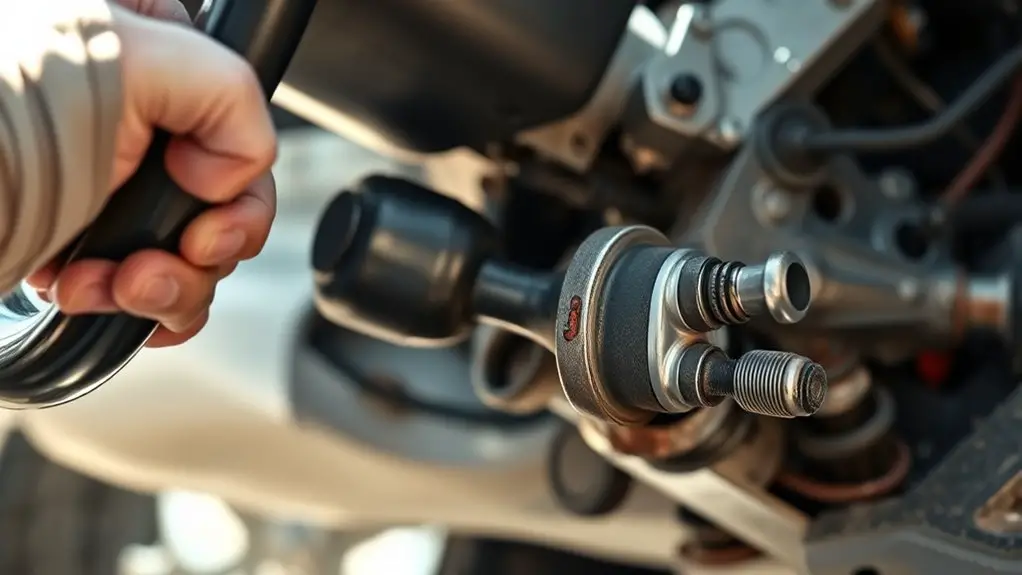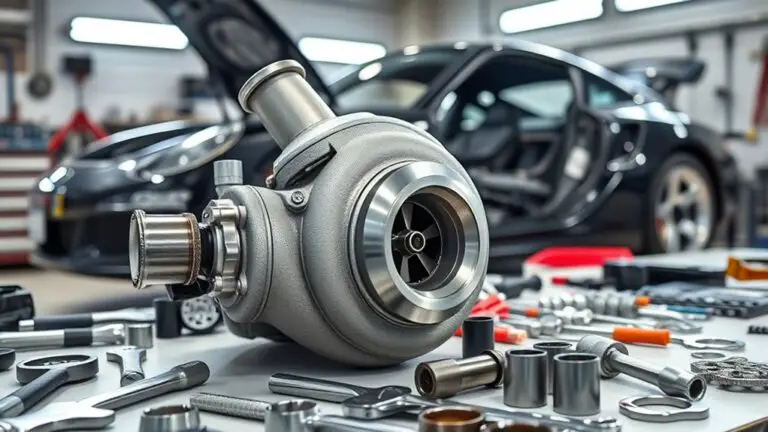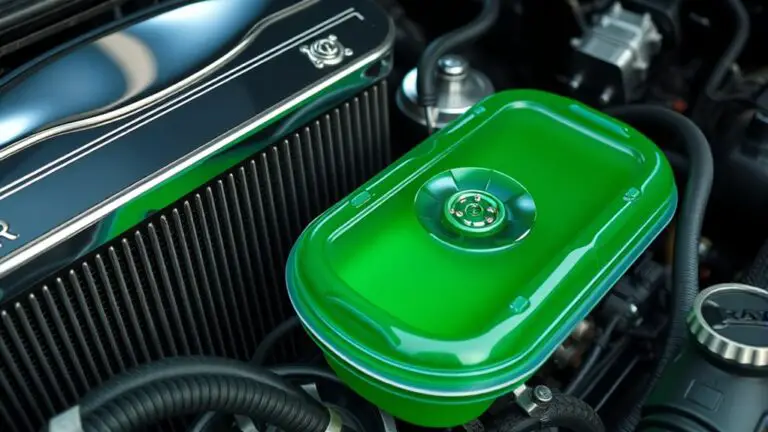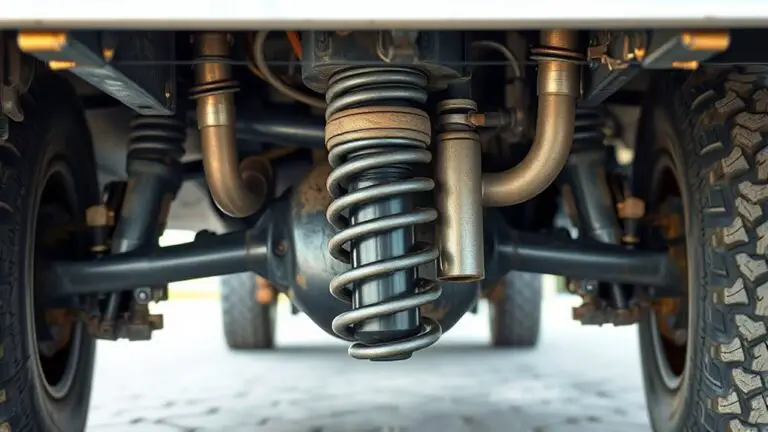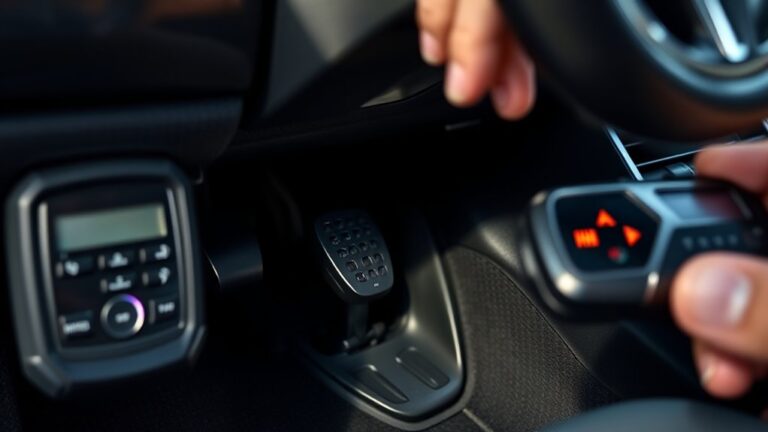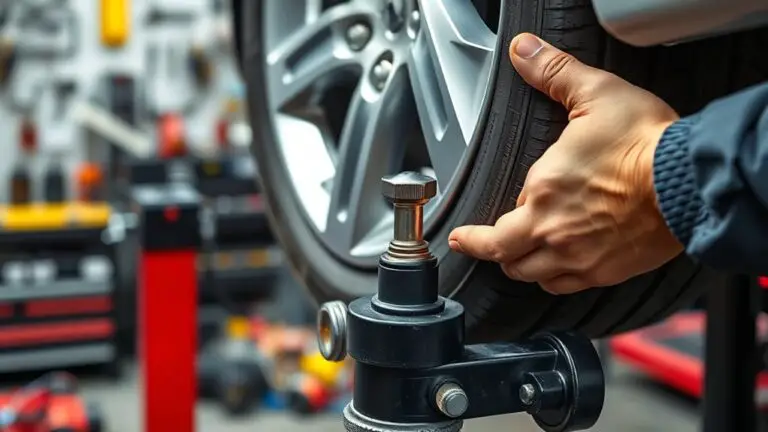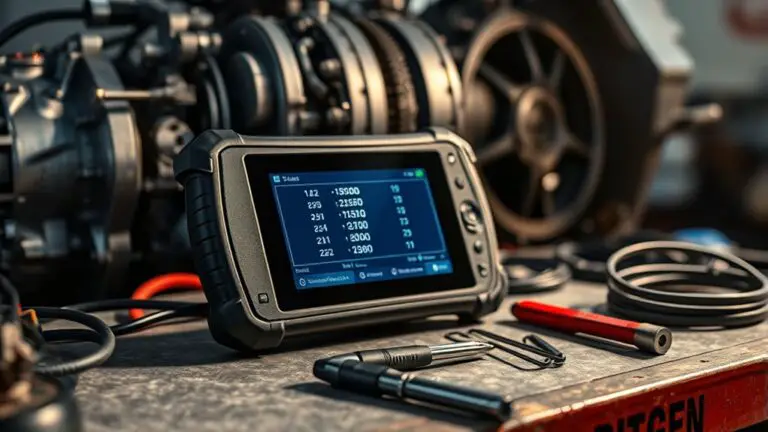How to Perform a Pre-Trip Suspension Check for Loose Steering
To perform a pre-trip suspension check for loose steering, start with a visual inspection of the steering linkage for play, wear, or bent parts, then test each joint by applying firm, controlled pressure to feel for looseness. Inspect tie rods and ends for bends, cracks, or torn boots, and shake them to reveal end play. Wobble the steering to detect rack or column play, and check shocks and bushings for leaks, movement, or noise. If issues arise, they’ll guide next steps as you proceed.
Checking Steering Linkage for Play
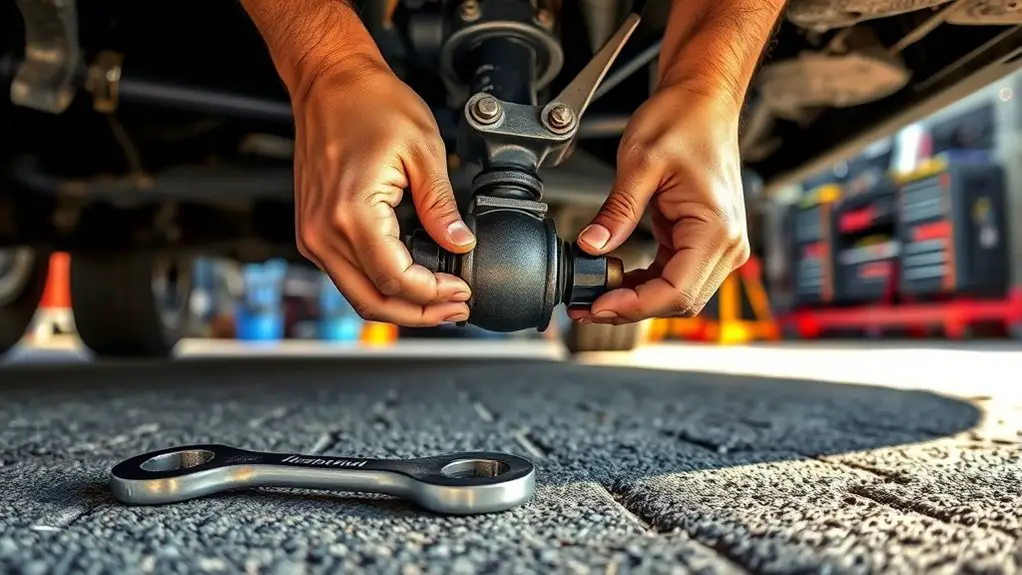
To check for play in the steering linkage, start with a visual inspection and then test for looseness at each linkage joint. You’ll assess the steering mechanics by locating movement gaps, wear marks, or bent components. With the engine off and wheels straight, grasp the steering arm, tie rod end, and pitman arm, then apply firm, controlled pressure in multiple directions. Note any audible clunks, binding, or excessive movement beyond specification. Move to the center of the linkage and verify that joints move smoothly without binding or looseness. Check for excessive play at the steering box and at joint splines by measuring vertical and horizontal displacement against manufacturer tolerances. Document findings and compare them to serviceable limits; if looseness exceeds limits, proceed to linkage maintenance steps or component replacement as required. Maintain a precise, procedural mindset to guarantee safe, reliable operation and clear pre-trip records.
Inspecting Tie Rods and Ends
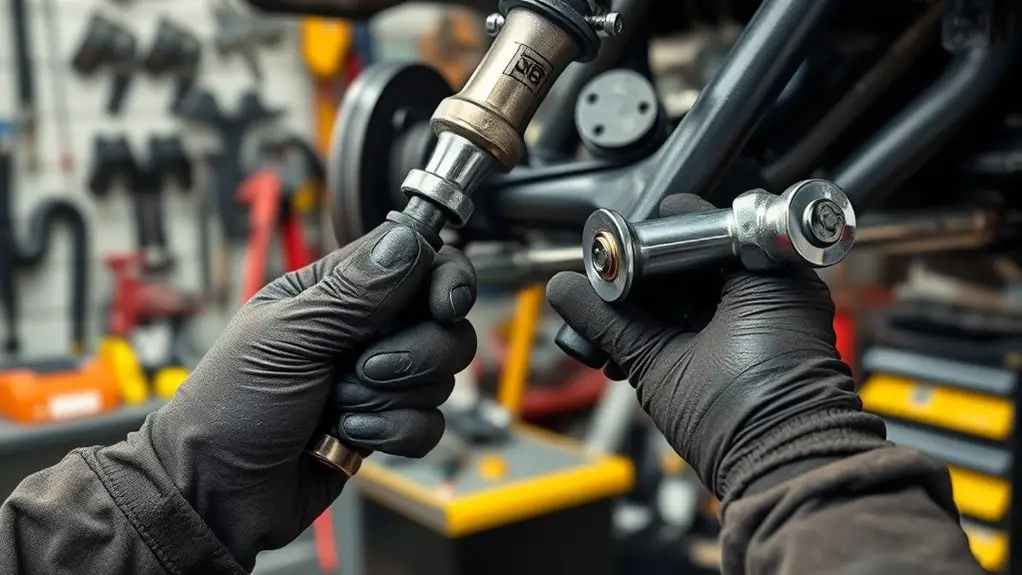
Inspecting tie rods and ends involves a systematic check of both the tie rod assembly and its end joints for play, wear, and damage. You’ll begin by visually inspecting for bends, cracks, and coating wear at the tie rod ends and cotter pins, if present. Next, test end play by grasping the wheel side of the tie rod end and the opposite end on the rod, then attempting to shake them for any looseness beyond manufacturer specifications. Listen for subtle clunks and feel for undue movement; compare left and right sides to detect asymmetry. With the vehicle on level ground and the wheels straight, rotate the steering slightly to reveal hidden play in the joint boots and dust seals. Record findings and proceed to tie rod maintenance steps only if measurements exceed tolerance. If end play is present, schedule service to prevent steering looseness and alignment drift. Avoid over-torquing the adjustment nuts during inspection.
Evaluating Steering Rack and Column
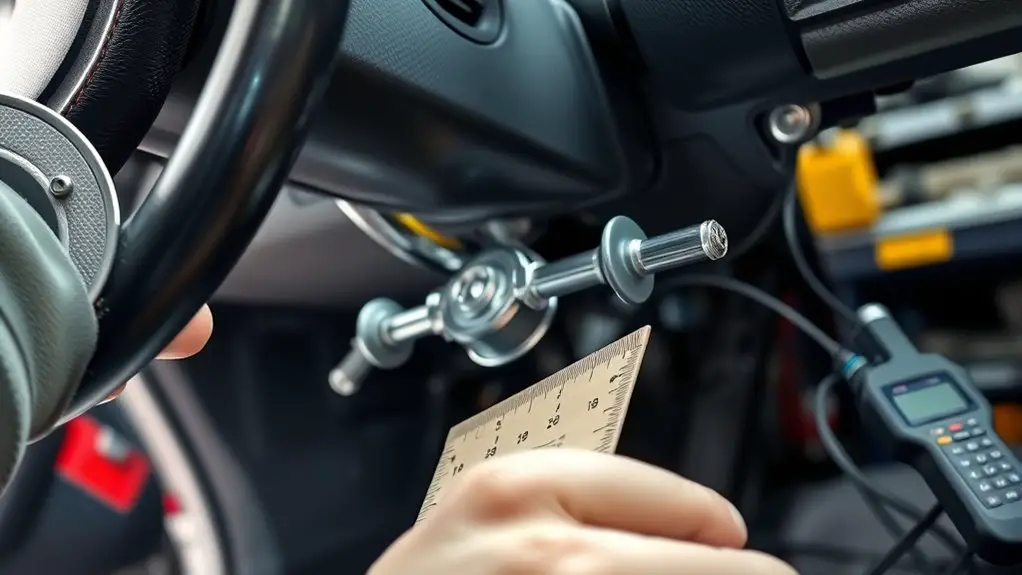
Evaluating the steering rack and column involves a focused check for play, leaks, and mechanical integrity in the rack-and-pinion assembly and the steering shaft. You’ll verify smooth transmittal of motion, identify any looseness, and affirm mounting hardware is secure, without over-tightening. Look for irregular sounds or binding during gentle rotation and turns, and inspect seals for seepage that could indicate a developing leak.
Evaluating the steering rack and column checks for play, leaks, and integrity to ensure smooth, secure steering.
- Check for rack play by gently wobbling the steering wheel and measuring any excessive motion at the steering column.
- Assess leaks at the rack, seals, and pinion housing; note oily residue or crusty buildup.
- Inspect the steering column for vertical looseness, binding, or misalignment, and confirm proper coupling to the steering shaft.
- Affirm steering alignment by tracing wheel centeredness after a light turn, and ensure column lubrication is adequate and free of contamination.
Assessing Suspension Components: Shocks, Ball Joints, and Bushings
Shifting from steering concerns into the suspension system, assess each component methodically to guarantee proper function and safe handling. You’ll test shocks for leaks, abnormal bounce, and top-out symptoms by applying controlled compression and release. Listen for clunking or squeaks that indicate loose mounts or worn bushings. Inspect ball joints for excessive play, torn boots, or grease leakage; move the wheel hub by hand to feel any binding. Check bushings for cracks, deformation, or excessive movement with the suspension at rest and under light load. Evaluate control arm and link connections for loose fasteners and misalignment. Record wear patterns and compare with manufacturer specs. For shocks maintenance, verify mounting integrity, check perches, and confirm dampening consistency across the axle. For bushing replacement readiness, note material condition and any intrusion into the control paths. Conclude with a concise log entry: findings, action needed, and priority.
Interpreting Findings and Next Steps
When interpreting your findings, start by comparing observed symptoms against manufacturer specs and baseline measurements taken during the pre-trip check. If discrepancies appear, map them to likely causes and prioritize actions that restore predictable steering feel and road control. Use objective thresholds to decide whether to proceed, defer, or escalate.
- Correlate steering feel changes with component play and binding; verify results with torque and motion tests.
- Flag any abnormal ride height or alignment shifts and document deviations for maintenance planning.
- Classify noises, leaks, or looseness by severity, then determine if simple tighten/adjust or full component replacement is required.
- Schedule maintenance tips and follow-up checks, ensuring torque specs, fastener integrity, and lubrication meet OEM standards.
Document findings succinctly, retain reference data, and communicate safety implications. If issues exceed tolerances, halt further driving and arrange professional inspection to maintain control, suspension performance, and freedom from undue risk.
Frequently Asked Questions
How Often Should I Perform a Pre-Trip Suspension Check?
You should perform a pre-trip suspension check every time you hit the road. This routine guarantees suspension maintenance and keeps steering alignment precise. Before you depart, inspect for loose components, abnormal wear, and leaks, then verify that mounts, bushings, and shocks are secure. If you find any issue, pause the trip, address it, and recalibrate alignment as needed. Regular checks empower you to travel confidently and maintain safe, responsive handling.
Can I Drive With Minor Steering Play Temporarily?
No, you shouldn’t drive with even minor steering play. Temporary solutions might seem tempting, but safety concerns override them. If you notice looseness, halt operation and inspect fasteners, joints, and linkages before moving. Do not rely on adjustments or makeshift fixes; tighten or replace components as specified. Schedule a proper inspection, then test drive only after verification. Your freedom to travel safely hinges on addressing suspension issues before you continue driving.
What Tools Are Essential for Quick Checks?
Skipping the fluff, you’ll need essential tools: a torque wrench, adjustable wrench, ratchets, and basic screwdrivers. Start with a quick stat: about 85% of steering failures involve loose components found during checks. For a precise inspection, use a wrench types set to verify torque specs, then follow your inspection checklist to confirm linkage, tie rods, and bushings are secure. Keep the process fast, methodical, and safety-forward. If it fails, don’t drive.
Do Steering Issues Affect Tire Wear Immediately?
Yes, steering issues can affect tire wear promptly. If you notice instability, misalignment, or wandering, tires wear unevenly and wear rate can jump. You’ll want to confirm tire alignment and steering stability during checks, especially when you feel grabs or pulls. Addressing root causes early prevents accelerated wear, vibration, and handling changes. Maintain proper tire pressure, inspect components, and recalibrate alignment as needed to keep steering precise and tires lasting longer.
Should I Replace Components in Pairs or Individually?
Yes, you should replace components in pairs when they’re related, to preserve component compatibility and alignment. If one part shows wear or failure, often its mate is similarly compromised, so swapping both improves cost efficiency by reducing repeat service. Maintain proper torque specs, and verify wheel alignment after replacement. Document parts’ compatibility with your vehicle model, and avoid mixing different brands unless the designs guarantee equal performance. This approach supports reliable, balanced handling.

